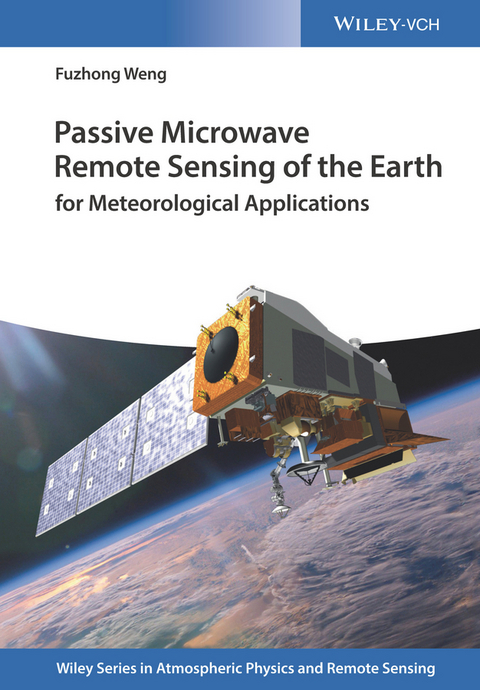Passive Microwave Remote Sensing of the Earth
Wiley-VCH (Verlag)
978-3-527-33627-2 (ISBN)
- Titel ist leider vergriffen;
keine Neuauflage - Artikel merken
Dr. Fuzhong Weng received his PhD degree in 1992 from Department of Atmospheric Science, Colorado State University (CSU), Fort Collins, Colorado, USA. He joined NOAA in 1998 as a physical scientist and then managed the US Joint Center for Satellite Data Assimilation Program (JCSDA) from 2002-2005. He served as the chief of sensor physics branch at NOAA/NESDIS from 2005-2010. From 2011 to 2017, Dr. Weng was appointed as the chief of Satellite Meteorology and Climatology of NOAA/NESDIS/Center for Satellite Applications and Research, JCSDA Senior Scientist and Joint Polar Satellite System (JPSS) Sensor Science Chair. He won a number of awards including the first winner of the 2000 NOAA David Johnson Award for his outstanding contributions to satellite microwave remote sensing fields and the utilization of satellite data in the NWP models, US Department of Commerce Gold Medal Award in 2005 for his achievement in satellite data assimilation, NOAA bronze medal for leading successful NOAA-18 instrument calibration, and NOAA Administrator's Award for developing new and powerful radiative transfer models to assimilate advanced satellite data in 2009 and NOAA Administrator's Award for leadership in developing a state-of-the art satellite instrument health monitoring system enabling corrective actions to extend instrument life. He published over 160 papers in US and other international journals.
Chapter 1: Introduction
*Review of US and international operational satellite programs that have microwave imagers and sounders on board and their major mission goals in the Earth environmental monitoring
Chapter 2: Satellite Microwave Radiometer System
Introduce microwave radiometer system components,
Radiometric linear and nonlinear calibration,
Antenna theory including characterization of APC gain, spill-over from side-lobe and polarization,
Backus-Gilbert resampling for noise reduction and foot print matching
On-orbit absolute calibration from GPSRO data, and characterization of scan angle correction.
Chapter 3: Atmospheric Absorption and Scattering
Optical parameters used in atmospheric remote sensing
Absorption spectrum from oxygen and water vapor, Zeeman splitting
Scattering properties from cloud hydrometeors and approximation form on phase matrix and Rayleigh approximation,
Chapter 4: Microwave Radiative Transfer Theory
Requirements for microwave radiative transfer (e.g. full vector model)
General radiative transfer modeling and discrete ordinate method
Approximation leading to emission and scattering based radiative transfer used for remote sensing
Ocean surface emissivity model (two-scale approximation)
Land surface emissivity model including snow dense medium approach
Chapter 5: Microwave Atmospheric and Environmental Remote Sensing
Atmospheric temperature and water profile, cloud liquid/ice,
Land surface parameters including surface emissivity, temperature, soil moisture and snow cover
Ocean surface parameters including SST and SSW, sea ice concentration
Global radio-frequency interference (RFI) using normalized PCA and double NPCA
Chapter 6: Applications of Microwave Data in Weather Event Monitoring and Forecasts
Hurricane and typhoon warm core analysis
Balanced wind analysis from microwave sounders
Satellite data assimilation and quality control
Impacts of satellite data assimilation on hurricane track and intensity forecasts
Flood monitoring
Chapter 7: Applications of Microwave Data in Climate Research
Requirements for monitoring climate trends from satellites
Cross calibration of microwave data for fundamental climate data record
Analysis of climate trend of microwave sounder and imager
| Erscheinungsdatum | 17.08.2017 |
|---|---|
| Reihe/Serie | Wiley Series in Atmospheric Physics and Remote Sensing |
| Mitarbeit |
Herausgeber (Serie): Alexander Kokhanovsky |
| Verlagsort | Weinheim |
| Sprache | englisch |
| Maße | 170 x 244 mm |
| Gewicht | 884 g |
| Themenwelt | Naturwissenschaften ► Geowissenschaften ► Geologie |
| Naturwissenschaften ► Physik / Astronomie ► Angewandte Physik | |
| Technik ► Umwelttechnik / Biotechnologie | |
| Schlagworte | atmospheric sciences • atomic and molecular physics • Atom- u. Molekülphysik • Chemie • Chemistry • earth sciences • Environmental Chemistry • environmental physics • Fernerkundung • Geowissenschaften • GIS & Remote Sensing • GIS & Remote Sensing • GIS u. Fernerkundung • Klimatologie • Klimatologie u. Meteorologie • Meteorologie • meteorology • Mikrowellen • Physics • Physik • Umweltchemie • Umweltphysik |
| ISBN-10 | 3-527-33627-3 / 3527336273 |
| ISBN-13 | 978-3-527-33627-2 / 9783527336272 |
| Zustand | Neuware |
| Haben Sie eine Frage zum Produkt? |
aus dem Bereich




